Garvey On "What’s Wrong With The FAA?"
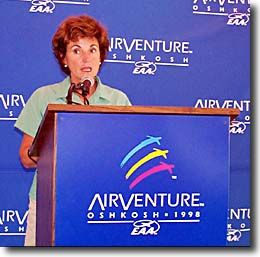 Communication. Surprises. Resources. These were the three main themes that FAA Administrator Jane Garvey stressed as problem areas on which she is working in response to AVweb‘s Mike Busch asking: "What’s wrong with the FAA?" Garvey’s comments came Monday during an exclusive AVweb interview conducted by telephone between Oshkosh and Washington. The interview came as AVweb was preparing to launch its coverage of EAA’s AirVenture ’99 and as Ms. Garvey prepared to travel to OSH on Sunday for her annual "Meet The Boss" session.
Communication. Surprises. Resources. These were the three main themes that FAA Administrator Jane Garvey stressed as problem areas on which she is working in response to AVweb‘s Mike Busch asking: "What’s wrong with the FAA?" Garvey’s comments came Monday during an exclusive AVweb interview conducted by telephone between Oshkosh and Washington. The interview came as AVweb was preparing to launch its coverage of EAA’s AirVenture ’99 and as Ms. Garvey prepared to travel to OSH on Sunday for her annual "Meet The Boss" session.
So, what is wrong with the FAA and where does AVweb get offwith point-blank asking the administrator such a question? The answer is not aneasy one, nor have the issues that give us cause to ask it arisen overnight.Instead, it’s one that has been a growing, nagging concern among many in theaviation industry. Granted, things could be worse — a lot worse. All signspoint to strong and sustained upswings in the industry, including record newaircraft sales numbers and high student start rates. Safety is much-improved,also, with preliminary NTSB statistics pointing to 1998 being the safest year onrecord. Plus, we do have an administrator who takes the time to answerquestions, to listen to the grass roots of aviation. She is also willing —perhaps eager — to intervene when underlings at the agency roam "off thereservation." Two cases in point were the subject of Monday’s one-on-oneinterview between Garvey and Busch.
The first was the story of Bill Bainbridge. Anyone who was at last year’s"Meet The Boss" session would remember it. In an emotional speech,Bainbridge asked for the FAA to withdraw its enforcement action against him, andGarvey publicly instructed the FAA’s Deputy Chief Counsel, James Whitlow, to takecare of it, then went further, meeting with Bainbridge and Whitlow afterwards inan attempt to put the matter to rest. Unfortunately, her best efforts backfiredwhen it turned out that the letter prepared by FAA counsel concluded with anobvious threat, instead of a much-needed apology. Although the Bainbridge sagais concluded, there is no question that it received attention at the highestlevels. Ultimately, the issue was resolved, but not until even more interventionby Garvey on Bainbridge’s behalf.
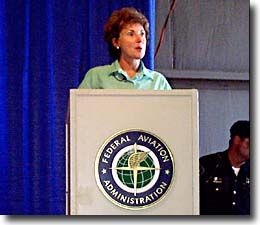 Thesecond example occurred earlier this month. For more than two years, the FAA hasbeen considering an internal draft of a proposed Airworthiness Directive onturbocharged twin Cessna exhaust systems. Less than a week before the FAAplanned to release the AD as a direct-to-final rule, the Cessna PilotsAssociation (CPA) and AOPA got wind of it. After getting their key pointsstraight, they appealed the pending action directly to Garvey’s office. Garveyherself responded to AOPA and the CPA via email to acknowledge receipt of theirletters, promising to get back shortly with a decision. Ultimately, the AD wasreleased as a proposed rule — affording industry the opportunity to comment.But the basic question that AVweb wanted to ask Garvey is, why did ithappen in the first place?
Thesecond example occurred earlier this month. For more than two years, the FAA hasbeen considering an internal draft of a proposed Airworthiness Directive onturbocharged twin Cessna exhaust systems. Less than a week before the FAAplanned to release the AD as a direct-to-final rule, the Cessna PilotsAssociation (CPA) and AOPA got wind of it. After getting their key pointsstraight, they appealed the pending action directly to Garvey’s office. Garveyherself responded to AOPA and the CPA via email to acknowledge receipt of theirletters, promising to get back shortly with a decision. Ultimately, the AD wasreleased as a proposed rule — affording industry the opportunity to comment.But the basic question that AVweb wanted to ask Garvey is, why did ithappen in the first place?
These and other notable events — including the infamous Bob Hoover episode— formed the basis for Busch’s question. We also asked Garvey about rumors thatshe may be leaving the FAA soon to take the position of Secretary ofTransportation in the event — also part of the rumor — that current SECDOTRodney Slater would resign. Read her responses to these and other questions in AVweb‘sPreview Coverage of AirVenture ’99.
EAA AirVenture — Behind The Flightline: The Sights, Sounds And Smells OfAirVenture ’99
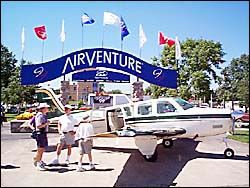 Where else in the world can the rabid fan of flying sample such a broad blendof aviation as in Oshkosh, Wis., in the late summer of each year? In many ways,you can look upon the gathering much like a bride’s wedding trousseau: a blend ofsomething old, something new, something borrowed and something blue — thedeep, clear blue of the Wisconsin sky.
Where else in the world can the rabid fan of flying sample such a broad blendof aviation as in Oshkosh, Wis., in the late summer of each year? In many ways,you can look upon the gathering much like a bride’s wedding trousseau: a blend ofsomething old, something new, something borrowed and something blue — thedeep, clear blue of the Wisconsin sky.
With the opening today of the Experimental Aircraft Association’s annualconvention, the air over Wittman Regional Airport will carry a thick, sweetaroma blended from scents of avgas and Jet A, grilled bratwurst and burgers,roasted corn-on-the-cob and cool lemonade. It’s such an intoxicating scent thatone sample could make any veteran of Oshkosh salivate as surely as Pavlov’s pupsresponding to the ring of a bell — if you could bottle it, at any rate.
The minute-by-minute rumbling of huge, round warbird engines contrasts withthe soft ringing whine of two-stroke ultralight engines as much as the sight ofdainty antique homebuilts taxiing past behemoths like the airliners parked onthe West Ramp.
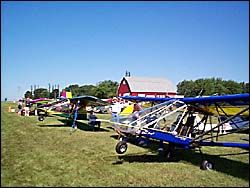 AirVenture ’99 is a sprawling city of airplanenuts and their families and friends — tens of thousands of them living comfortably in tents, campers andmotorhomes in the vastness of Camp Scholler. Thousands more pull tents from theplanes, string hammocks in the shadows of their wings and settle into the vastopen green of the North Forty Aircraft Camping area, in the Warbirds staging areato the east, around the centrally located Theater in the Woods and in theultralight field adjacent to the southern end of Runway 18/36.
AirVenture ’99 is a sprawling city of airplanenuts and their families and friends — tens of thousands of them living comfortably in tents, campers andmotorhomes in the vastness of Camp Scholler. Thousands more pull tents from theplanes, string hammocks in the shadows of their wings and settle into the vastopen green of the North Forty Aircraft Camping area, in the Warbirds staging areato the east, around the centrally located Theater in the Woods and in theultralight field adjacent to the southern end of Runway 18/36.
More Than Just An Airshow
You should have the idea by now. Oshkosh is a place of contrasts, attended byhundreds of thousands who are tended by more than 10,000 volunteers, many ofthem veterans of decades of manning the flightlines, campgrounds, informationbooths, type club buildings, parking lots, taxiways and runways.
Oshkosh may be the one place on earth where an avid aviator can see newplanes, new avionics, new engines and more new gadgets than any kid ever dreamtof for Christmas Day. For example, where else might you find two all-newautogyro designs, both four-place, that are not direct competitors?
You can see it here. The Groen Brothers’ Hawk 4 gyro aspires to be the newstandard in utility aircraft, targeted at a niche of operators in betweenhelicopters and fixed-wing planes, such as pipeline patrol, power-linemaintenance, television news-gathering and environmental patrols, where slowspeed and low flying are the standard. In contrast, the Carter Copter shoots forthe business-aviation strata, pressurized for high-altitude, high-speedperformance.
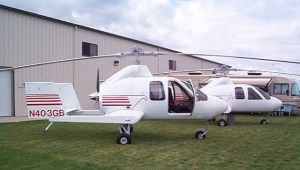 Oshkosh is where Ballistic Recovery Systems has chosen to unveil a newaircraft-recovery parachute system for retrofit in Cessna 172 Skyhawks, whileAviat Aircraft hopes to debut its retro hotrod, the 200-mph Monocoupe 110Special, scant days after its first flight in Afton, Wyo. And QuicksilverManufacturing, maker of the oldest line of ultralights available, will show offa new two-place trainer vastly redesigned from the venerable MX line.
Oshkosh is where Ballistic Recovery Systems has chosen to unveil a newaircraft-recovery parachute system for retrofit in Cessna 172 Skyhawks, whileAviat Aircraft hopes to debut its retro hotrod, the 200-mph Monocoupe 110Special, scant days after its first flight in Afton, Wyo. And QuicksilverManufacturing, maker of the oldest line of ultralights available, will show offa new two-place trainer vastly redesigned from the venerable MX line.
Before AirVenture ’99 ends Tuesday, pilots will get their first glimpses ofGarmin’s new color-display GPSMAP 295 and the new AvTracker software programthat combines logbook keeping, cost tracking, partnership management andoperational alerts into a single homogenous package. Raytheon Aircraft Co.brought its first Jaguar Edition Bonanza and Barons for display, while CessnaAircraft jammed its exhibit with its full line of piston singles, a CitationJetand Caravan on floats.
And this just scratches the surface. You will read much more about many morenew products in the coming week.
Power To The People
But more than new planes and products, Oshkosh is where plane-loving peoplecome together each year to celebrate flight.
The EAA-member volunteers will celebrate their dedication and hard work witha parade all their own, winding through Camp Scholler in golf carts and JohnDeere Gators, garbage trucks and fire trucks with the lights and sirens blaring.
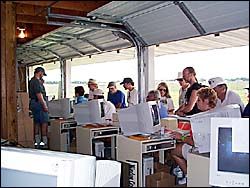 Dozens of volunteer docents at the EAA Museum will impart stories of sportaviation’s history to the uninitiated, complemented by the knowledge of crewsstaffing the antique hangars at Pioneer Airport across the way.
Dozens of volunteer docents at the EAA Museum will impart stories of sportaviation’s history to the uninitiated, complemented by the knowledge of crewsstaffing the antique hangars at Pioneer Airport across the way.
Each day the multitudes will crowd the flight line along 18/36 to watch acelebration of Airshow Legends with pilots cavorting through the sky withapparent abandon for hours, before heading south on the field to watch another90 minutes of action as colorful ultralights and powered parachutes dot theevening sky, flown by average owners with as much pride and precision as anyprofessional performer.
It’s at AirVenture that two score volunteers in the Emergency Aircraft Repairarea attend to the foibles and failures of a couple of hundred pilots cursedwith an airplane problem that must be solved before they can safely wing homeagain.
And each evening, as the field closes to traffic and the sounds of aviationdie as slowly as the light, thousands of the hard core will amble from campfireto campfire, making new friendships and renewing old ones.
In the coming days we’ll take you for a peek behind the flight line, the newsconferences and new-product announcements to meet some of the people who make itwork, make it large and make it aviation’s perennial top fly-in and air show.We’ll try to paint you a picture of airshow life as it ebbs and flows witheach sunset and sunrise. And, we hope, you’ll come away with enough of the funand friendship to make staying away next year harder than ever.
So, until tomorrow, safe flying, everybody.
Weather Throws Curve At Pilots in AirVenture Cup Race
The hot, humid weather spawning thunderstorms throughout the middle of theU.S. delayed, but couldn’t stop, the 15 contestants in the second annual EAAAirVenture Cup Race this week. Originally slated to start Monday from an airportnear Kitty Hawk, N.C.,and finish the same day at Oshkosh, Wis., the racers wereforced to make an unscheduled stop in Dayton, Ohio, when the weatherdeteriorated along the course route. After waiting out the weather overnight inDayton, the pilots finished the race on Tuesday morning under a cloudless bluesky at Oshkosh.
The objective of the AirVenture Cup race is a flat-out speed dash forexperimental aircraft over an 825-nm dogleg course, testing thenavigation and piloting skills of the participating flight crews. The aircraftwith the shortest time is the overall winner. The dogleg allows the competitorsto avoid the congested airspace around Chicago’s O’Hare Airport by passing overa pylon in Aurora, Ill., before turning north. The aircraft compete in three racecategories depending on engine displacement and whether they have retractablegear. Some of the aircraft types that competed this year included Lancairs,Long-Ezs, Berkuts, and RVs.
When all the results were finally calculated, Jim Rahm of Daytona, Fla.,flying a Lancair IVP, was declared the overall winner with a total flight timeof 3 hours 57 minutes and 29 seconds. Rahm’s average speed over the course was239.69 mph. Placing first in the Formula RG category was Dick Keyt of Granbury,Texas, in a Polen Special II, with a time of 4 hours 4 minutes and 46 seconds,which works out to an average speed of 232.56 mph. In the Formula FX category,Don Saint from Granbury, Texas, took home the gold flying a Glasair IIS in 4 hours49 minutes and 18 seconds, at an average speed of 196.77 mph.
AirVenture Cup Race organizers were quick to praise the great help theyreceived from volunteers at Dayton’s Wright Brothers Airport. On short noticethe Dayton volunteers provided accurate timing to insure the validity of thescoring, found overnight accommodations for the flight crews, and hangared therace planes to provide protection from the thunderstorms that rumbled throughovernight. Race winners will be honored at a Theater in the Woods trophypresentation the evening of July 28.
A Marvel Of Design Features
One of the great things about AirVenture is seeing the numerous one-of-a-kind aircraft that show up every year. AVweb caught up with the contingent from Mississippi State University before the show opened as they unloaded the Marvel II observation aircraft from its trailer after a two-day trek from Starkville. Tom Hannigan, laboratory coordinator with the MSU department of aerospace engineering, explained that the Marvel prototype was designed and built at the school for use as an observation plane in Saudi Arabia. The Marvel features composite construction, a mid-fuselage wing, a helicopter-like bubble nose, and a 250 shp J10 turboprop coupled to a ducted pusher prop. The duct was incorporated to protect the prop from foreign-object damage when operating from dirt or sand runways, and not for noise reduction or prop efficiency as in most ducted fan designs.
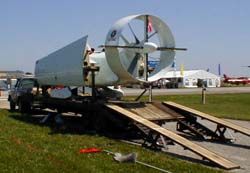 Another interesting feature of the Marvel II is the four-wheel landing gear arranged in parallel tandem configuration. Hannigan explained that this landing-gear arrangement allowed the Marvel II to take off and land on soft sand runways typical of Saudi Arabia. The original Marvel had a unique camber-changing wing, but the Marvel II being shown here has a conventional wing design. The MSU aerospace engineering department also did design work for Honda in the early ’90s on a prototype aircraft powered by a Honda engine. The Honda plane, now retired, is on display in a museum in Japan. AirVenture visitors who want to take a close look at the Marvel II and find out more about the interesting work being done at MSU can stop by the display on the south side of the main display ramp.
Another interesting feature of the Marvel II is the four-wheel landing gear arranged in parallel tandem configuration. Hannigan explained that this landing-gear arrangement allowed the Marvel II to take off and land on soft sand runways typical of Saudi Arabia. The original Marvel had a unique camber-changing wing, but the Marvel II being shown here has a conventional wing design. The MSU aerospace engineering department also did design work for Honda in the early ’90s on a prototype aircraft powered by a Honda engine. The Honda plane, now retired, is on display in a museum in Japan. AirVenture visitors who want to take a close look at the Marvel II and find out more about the interesting work being done at MSU can stop by the display on the south side of the main display ramp.
Cajun Condo Camp
An obvious incentive for arriving at AirVenture before the show starts is to get first shot at the best campsites. AVweb visited the "Cajun Condo" camp nestled in a grove of tall trees in the Antique/Classic aircraft camping area. Camp founder Joe Champagne is the chief pilot for Air Grand Canyon, and flies Cessna 207s out of Grand Canyon Airport, in Arizona. Champagne, originally from New Orleans, has been coming to Oshkosh for 22 years, and tries to get into Wittman Field a week before the show starts to stake his claim on this prime campsite.
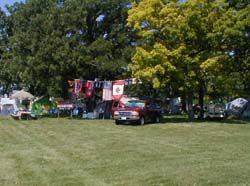 Joe’s camp has grown over the years, and now includes more than 50 inhabitants from various countries, as evidenced by the numerous national flags flying over the camp entrance. Joe said one of the prime reasons he attends Oshkosh is to visit with all the friends he has made here, many of whom have become "citizens" of his camp. Although the citizens’ planes are parked nearby in the hot sun, their tents are arranged in a loose circle in the shade of the trees. Anyone who has ever camped at Oshkosh knows that many pilots would willingly trade a tankful of avgas for a shaded campsite when the inevitable heat and humidity descends on the convention.
Joe’s camp has grown over the years, and now includes more than 50 inhabitants from various countries, as evidenced by the numerous national flags flying over the camp entrance. Joe said one of the prime reasons he attends Oshkosh is to visit with all the friends he has made here, many of whom have become "citizens" of his camp. Although the citizens’ planes are parked nearby in the hot sun, their tents are arranged in a loose circle in the shade of the trees. Anyone who has ever camped at Oshkosh knows that many pilots would willingly trade a tankful of avgas for a shaded campsite when the inevitable heat and humidity descends on the convention.
Every year at Cajun Condo, Joe and his buddies cook up 50 gallons of good old Cajun gumbo to share among the camp residents and anyone else who happens to wander by. This year Oshkosh won’t be all fun for Joe, though — he brought along as light reading the FAA proposal for new restrictions on Grand Canyon overflights. According to Joe, if enacted, the proposed changes in the two-inch-thick document would have a drastic impact on tour operators who conduct scenic flights over the Grand Canyon.
North Forty Aircraft Camping
By Sunday morning, airplanes were already starting to fill in the preferred campsites in the area surrounding Runway 9/27 on the north end of Wittman Field. Known as the North Forty, this area is the designated parking and camping area for the majority of spam cans that are not allowed in the EAA-designated aircraft parking areas for Warbirds, Antiques, Ultralights, Classics, or Experimental. AVweb visited Bill Sellers and Vernon Roper of Marysville, Calif., occupants of campsite row 1, space A, the primo spot closest to the convention grounds. Arriving on the Thursday before the start of the convention in a pristine Cessna Skyhawk XP II, Sellers said he lucked out in getting this choice spot.
Also arriving Thursday was a Cherokee 140 piloted by Barrie Keal. He and his wife, Sylvia, flew from their home in Georgetown, Ontario, across Michigan’s Upper Peninsula so they could make a dinner stop at their favorite en route restaurant in Manistee, Mich. They wound up in row 1, spot E. Their first priority was to make friends with the owners of a nearby 172, because you can’t sit in the shade of a Cherokee wing.
Thursday arrivals were steered away from the coveted area at first, because the ground was waterlogged. When rows 1 and 2 finally dried out Saturday, Sellers’ Hawk XP was the first plane directed to taxi and he got row 1, spot A. Sellers has been to Oshkosh many times, but this was the first time for Roper. Roper said they were looking forward to taking their chairs out to the end of row 1, which stops near the midpoint of 9/27, to "grade" the landings of arriving planes. They’ll have plenty of opportunities to critique fellow pilots as traffic increases dramatically over the next few days, especially when two planes land simultaneously on the runway during peak times.
You’ve Fought Headwinds, TRWs And Traffic
And Now You Get To Hassle Over Where To Park
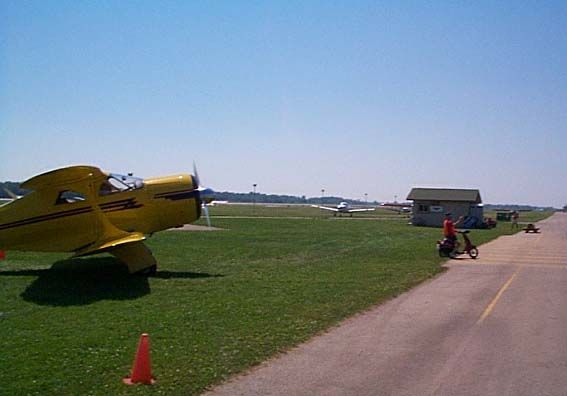 Michael Hoag has volunteered for parking duty for the last 19 years. He’s one of about 25 volunteers who spend a few days before AirVenture trying to keep the traffic moving. After guiding this Staggerwing Beech to its home for the week, he took a moment to explain the system. Once the airplane leaves the runway, FAA controllers send it to the appropriate parking area for its category. Then each area’s point manager looks for a sign in the window that pilots are asked to display showing their destination, and assigns the airplane to a volunteer on a motorbike who guides it to a full stop. The full details on the parking system are spelled out in detail at EAA’s web site.
Michael Hoag has volunteered for parking duty for the last 19 years. He’s one of about 25 volunteers who spend a few days before AirVenture trying to keep the traffic moving. After guiding this Staggerwing Beech to its home for the week, he took a moment to explain the system. Once the airplane leaves the runway, FAA controllers send it to the appropriate parking area for its category. Then each area’s point manager looks for a sign in the window that pilots are asked to display showing their destination, and assigns the airplane to a volunteer on a motorbike who guides it to a full stop. The full details on the parking system are spelled out in detail at EAA’s web site.
Parking is a potential choke point in the system. If the airplanes don’t get parked efficiently, they back up on the taxiway, which causes runway congestion, which means the tower tells Fisk to start holding at Ripon, and some pilot ends up doing doughnuts over Ohio.
When Michael’s not parking airplanes, he’s got seven Aeroncas to keep him busy. One is flying, one is halfway through restoration and the other five are in various stages of disarray. But again this year he’s spending his time welcoming some of the 11,000 arriving airplanes to a home away from home for EAA’s AirVenture.
And The Judge From Cincinnati Gives That Landing A 9.5
How do you pass the time when you fly into AirVenture ’99 four days beforethe show starts? If you are Bob Gardner and Russ Lee of Cincinnati, Ohio, youplop yourself down in your lawn chairs along Runway 9/27 and critique thelandings of fellow pilots arriving for the big show. AVweb found Gardnerand Lee armed with an airband scanner and video camera as they reviewed thecontinuous stream of arriving aircraft the day before the show opened. Gardnertold AVweb that they flew in from Lunken Airport near Cincinnati onSaturday in a Piper Archer, and that sitting by the runway in their lawn chairsanalyzing the landing skills of pilots was a good way to pass the time until thereal airshow began. Gardner has been coming to AirVenture for the past threeyears, and for him this is one of the most entertaining parts of the Oshkoshexperience.
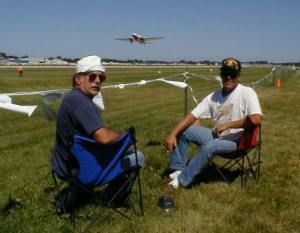 Comparedto the past two years, Gardner and Lee felt that the arriving traffic this daywas lighter than usual, and that the patterns and landings were all prettyrespectable, with nothing real memorable happening. Not like the incident thatoccurred several years ago that Gardner fondly remembers. In that event, the OSHtower had instructed a Cessna following a P-51 on downwind to Runway 27 toreport when he had the Warbird in sight. The Cessna pilot repeatedly transmittedthat he didn’t see the Mustang, even though he was right behind. Finally theMustang pilot belched out a big puff of smoke from his engine and transmitted:"Now can that dang Cessna see me?" Gardner said the crowd of planewatchers lining RW 27 let out a big laugh on hearing that on their radios.Gardner is building a Loehle P-40 replica that he hopes to fly to AirVenturesometime in the future. When that happens, the tables will be turned, as you canbet there will be a panel of "judges" scoring his Oshkosh landing.
Comparedto the past two years, Gardner and Lee felt that the arriving traffic this daywas lighter than usual, and that the patterns and landings were all prettyrespectable, with nothing real memorable happening. Not like the incident thatoccurred several years ago that Gardner fondly remembers. In that event, the OSHtower had instructed a Cessna following a P-51 on downwind to Runway 27 toreport when he had the Warbird in sight. The Cessna pilot repeatedly transmittedthat he didn’t see the Mustang, even though he was right behind. Finally theMustang pilot belched out a big puff of smoke from his engine and transmitted:"Now can that dang Cessna see me?" Gardner said the crowd of planewatchers lining RW 27 let out a big laugh on hearing that on their radios.Gardner is building a Loehle P-40 replica that he hopes to fly to AirVenturesometime in the future. When that happens, the tables will be turned, as you canbet there will be a panel of "judges" scoring his Oshkosh landing.
Two Down…
Each year, no matter how careful we all are, a handful of us manage to prang an aircraft — or worse. So far, AVweb is not aware of any serious accidents involving those of us trying to get to OSH. We are aware of a very nice Bellanca 260 that landed in Indiana while en route to OSH but couldn’t get its nosegear down. The Bellanca’s occupants emerged unscathed, but the Bellanca will need some work. Jim Duca of Boulder, Colo., had his share of Oshkosh excitement on his way to AirVenture ’99 when the right front cowling latch on his Stinson 108 failed a few miles east of Mason City, Iowa. The slipstream picked up the cowling and ripped off its right rear latch, leaving the remnants flapping in Duca’s face. Making right turns to keep the cowling pressed down, Duca returned to Mason City and lined up on the nearest runway, making an uneventful downwind landing. "I thought I was going to have to land it in a field," Duca said. "I didn’t hear anyone in the pattern, so I didn’t bother much with protocol." Duca will miss AirVenture ’99 but hopes to repair the Stinson and return in the future.
Let’s all be careful out there, okay?


































